Effect of Organic Amendments and Nano-Zinc Foliar Application on Alleviation of Water Stress in Some Soil Properties and Water Productivity of Barley Yield
Abstract
1. Introduction
2. Materials and Methods
2.1. Materials
2.2. Field Experiment Site
2.3. Field Experiment Design
2.4. Studied Traits
2.4.1. Agronomical Parameters
2.4.2. Water Relations Parameters
2.4.3. Soil Properties
2.5. Data Analysis
3. Results and Discussion
3.1. Effect of Organic Soil Amendments and Nano-Zn Foliar Spraying on Agronomical Traits under Irrigation Supplements
3.2. Effect of Organic Soil Amendments and Nano-Zn Foliar Spraying on Water Relations Parameters
3.3. Effect of Organic Soil Amendments and Nano-Zn Foliar Spraying on Some Soil Characteristics under Irrigation Supplements
3.4. Relationship among All Studied Traits as Affected by the Interaction among Irrigation Supplements, Organic Amendment, and Nano-Zn Foliar Spraying Treatments
4. Conclusions
Study Limitations
Future Directions
Supplementary Materials
Author Contributions
Funding
Data Availability Statement
Acknowledgments
Conflicts of Interest
References
- Fries, A.; Silva, K.; Pucha-Cofrep, F.; Oñate-Valdivieso, F.; Ochoa-Cueva, P. Water balance and soil moisture deficit of different vegetation units under semiarid conditions in the andes of southern Ecuador. Climate 2020, 8, 30. [Google Scholar] [CrossRef]
- Stanley, J.-D.; Clemente, P.L. Increased land subsidence and sea-level rise are submerging Egypt’s Nile Delta coastal margin. GSA Today 2017, 27, 4–11. [Google Scholar] [CrossRef]
- Shokr, M.E. Environmental applications of remote sensing in Egypt: A review and an outlook. Environ. Remote Sens. Egypt 2020, 95–126. [Google Scholar]
- Kadam, N.N.; Xiao, G.; Melgar, R.J.; Bahuguna, R.N.; Quinones, C.; Tamilselvan, A.; Prasad, P.V.V.; Jagadish, K.S. V Agronomic and physiological responses to high temperature, drought, and elevated CO2 interactions in cereals. Adv. Agron. 2014, 127, 111–156. [Google Scholar]
- Kebede, A.; Kang, M.S.; Bekele, E. Advances in mechanisms of drought tolerance in crops, with emphasis on barley. Adv. Agron. 2019, 156, 265–314. [Google Scholar]
- Sehgal, A.; Sita, K.; Bhandari, K.; Kumar, S.; Kumar, J.; Vara Prasad, P.V.; Siddique, K.H.M.; Nayyar, H. Influence of drought and heat stress, applied independently or in combination during seed development, on qualitative and quantitative aspects of seeds of lentil (Lens culinaris Medikus) genotypes, differing in drought sensitivity. Plant Cell Environ. 2019, 42, 198–211. [Google Scholar] [CrossRef]
- Liang, D.; Ni, Z.; Xia, H.; Xie, Y.; Lv, X.; Wang, J.; Lin, L.; Deng, Q.; Luo, X. Exogenous melatonin promotes biomass accumulation and photosynthesis of kiwifruit seedlings under drought stress. Sci. Hortic. 2019, 246, 34–43. [Google Scholar] [CrossRef]
- Forster, B.P.; Ellis, R.P.; Moir, J.; Talame, V.; Sanguineti, M.C.; Tuberosa, R.; This, D.; Teulat-Merah, B.; Ahmed, I.; Mariy, S. Genotype and phenotype associations with drought tolerance in barley tested in North Africa. Ann. Appl. Biol. 2004, 144, 157–168. [Google Scholar] [CrossRef]
- FAO (2017) Crops/Regions/World List/Production Quantity for Barley, 2014 (pick list). Food and Agriculture Organization Corporate Statistical Database (FAOSTAT). Available online: http://www.fao.org/faostat/en/#data/QC (accessed on 12 February 2017).
- Verma, S.; Yashveer, S.; Rehman, S.; Gyawali, S.; Kumar, Y.; Chao, S.; Sarker, A.; Verma, R.P.S. Genetic and Agro-morphological diversity in global barley (Hordeum vulgare L.) collection at ICARDA. Genet. Resour. Crop Evol. 2021, 68, 1315–1330. [Google Scholar] [CrossRef]
- Giraldo, P.; Benavente, E.; Manzano-Agugliaro, F.; Gimenez, E. Worldwide research trends on wheat and barley: A bibliometric comparative analysis. Agronomy 2019, 9, 352. [Google Scholar] [CrossRef]
- Bowden, C.L.; Evanylo, G.K.; Zhang, X.; Ervin, E.H.; Seiler, J.R. Soil carbon and physiological responses of corn and soybean to organic amendments. Compost Sci. Util. 2010, 18, 162–173. [Google Scholar] [CrossRef]
- Azab, E. Effect of water stress and biological fertilization on maize growth, chemical composition and productivity in calcareous soil. Am. J. Plant Physiol 2016, 11, 1–11. [Google Scholar] [CrossRef]
- Guo, L.; Wu, G.; Li, Y.; Li, C.; Liu, W.; Meng, J.; Liu, H.; Yu, X.; Jiang, G. Effects of cattle manure compost combined with chemical fertilizer on topsoil organic matter, bulk density and earthworm activity in a wheat–maize rotation system in Eastern China. Soil Tillage Res. 2016, 156, 140–147. [Google Scholar] [CrossRef]
- Cercioglu, M. The role of organic soil amendments on soil physical properties and yield of maize (Zea mays L.). Commun. Soil Sci. Plant Anal. 2017, 48, 683–691. [Google Scholar] [CrossRef]
- El-Sodany, M.; El-Maddah, E.; Abd-Allah, Y. Amelioration some physical and hydrophysical properties of clay loam soil using compost at different depths and nitrogen fertilizer rates. J. Soil Sci. Agric. Eng. 2018, 9, 601–613. [Google Scholar] [CrossRef]
- Aiad, M.A.; Amer, M.M.; Khalifa, T.H.H.; Shabana, M.; Zoghdan, M.G.; Shaker, E.M.; Eid, M.S.M.; Ammar, K.A.; Al-Dhumri, S.A.; Kheir, A. Combined application of compost, zeolite and a raised bed planting method alleviate salinity stress and improve cereal crop productivity in arid regions. Agronomy 2021, 11, 2495. [Google Scholar] [CrossRef]
- Huang, K.; Li, F.; Wei, Y.; Fu, X.; Chen, X. Effects of earthworms on physicochemical properties and microbial profiles during vermicomposting of fresh fruit and vegetable wastes. Bioresour. Technol. 2014, 170, 45–52. [Google Scholar] [CrossRef]
- Lalander, C.H.; Komakech, A.J.; Vinnerås, B. Vermicomposting as manure management strategy for urban small-holder animal farms–Kampala case study. Waste Manag. 2015, 39, 96–103. [Google Scholar] [CrossRef]
- Sinha, R.K.; Agarwal, S.; Chauhan, K.; Valani, D. The wonders of earthworms & its vermicompost in farm production: Charles Darwin’s ‘friends of farmers’, with potential to replace destructive chemical fertilizers. Agric. Sci. 2010, 1, 76. [Google Scholar]
- Hosseinzadeh, S.R.; Amiri, H.; Ismaili, A. Effect of vermicompost fertilizer on photosynthetic characteristics of chickpea (Cicer arietinum L.) under drought stress. Photosynthetica 2016, 54, 87–92. [Google Scholar] [CrossRef]
- Aksakal, E.L.; Sari, S.; Angin, I. Effects of vermicompost application on soil aggregation and certain physical properties. L. Degrad. Dev. 2016, 27, 983–995. [Google Scholar] [CrossRef]
- Wang, X.-X.; Zhao, F.; Zhang, G.; Zhang, Y.; Yang, L. Vermicompost improves tomato yield and quality and the biochemical properties of soils with different tomato planting history in a greenhouse study. Front. Plant Sci. 2017, 8, 1978. [Google Scholar] [CrossRef] [PubMed]
- Zhao, H.-T.; Li, T.-P.; Zhang, Y.; Hu, J.; Bai, Y.-C.; Shan, Y.-H.; Ke, F. Effects of vermicompost amendment as a basal fertilizer on soil properties and cucumber yield and quality under continuous cropping conditions in a greenhouse. J. Soils Sedim. 2017, 17, 2718–2730. [Google Scholar] [CrossRef]
- Khalifa, T.H.H.; SA Ramadan, M.; SM Eid, M. Using zeolite and vermicompost amendments to improve water productivity of wheat irrigated by low-quality water in the northern Nile Delta. IJPSS 2021, 33, 121–135. [Google Scholar] [CrossRef]
- Mansour, M.M. Response of soybean plants to exogenously applied with ascorbic acid, zinc sulphate and paclobutrazol. Rep. Opin. 2014, 6, 17–25. [Google Scholar]
- Naderi, M.R.; Abedi, A. Application of nanotechnology in agriculture and refinement of environmental pollutants. J. Nanotechnol. 2012, 11, 18–26. [Google Scholar]
- Ball, P. Natural strategies for the molecular engineer. Nanotechnology 2002, 13, R15. [Google Scholar] [CrossRef]
- Mukhopadhyay, S.S. Nanotechnology in agriculture: Prospects and constraints. Nanotechnol. Sci. Appl. 2014, 7, 63. [Google Scholar] [CrossRef] [PubMed]
- Fraceto, L.F.; Grillo, R.; de Medeiros, G.A.; Scognamiglio, V.; Rea, G.; Bartolucci, C. Nanotechnology in agriculture: Which innovation potential does it have? Front. Environ. Sci. 2016, 4, 20. [Google Scholar] [CrossRef]
- Noaman, M.M.; El-Sayed, A.A.; Assad, F.A.; El-Sherbini, A.M.; El-Bawab, A.O.; El-Moselhi, M.A.; Rizk, R.A. Giza 125″ and Giza 126″, two new barley cultivars for rainfed areas of Egypt. Egypt. J. Appl. Sci. 1995, 10, 418–432. [Google Scholar]
- Mariey, S.A.; El-Mansoury, M.A.M.; Agwa, A.M.E.; Nashed, M.E. Genetic diversity of egyptian barley cultivars for water stress using SSR markers. Int. J. Environ. 2020, 9, 14–25. [Google Scholar]
- Mohan, A.C.; Renjanadevi, B. Preparation of zinc oxide nanoparticles and its characterization using scanning electron microscopy (SEM) and X-ray diffraction (XRD). Procedia Technol. 2016, 24, 761–766. [Google Scholar] [CrossRef]
- Hansen, V.W.; Israelsen, D.W.; Stringharm, D.E. Irrigation Principle and Practices; Johns Willey &Sons: New York, NY, USA, 1979. [Google Scholar]
- Downy, L.A. Water use by maize at three plant densities. Exper. Agric. 1970, 7, 161–169. [Google Scholar] [CrossRef]
- Ali, M.H.; Hoque, M.R.; Hassan, A.A.; Khair, A. Effects of deficit irrigation on yield, water productivity, and economic returns of wheat. Agric. Water Manag. 2007, 92, 151–161. [Google Scholar] [CrossRef]
- Richards, L.A. Diagnosis and improvement of saline and alkali soils. LWW 1954, 78, 154. [Google Scholar] [CrossRef]
- Page, A.L.; Miller, R.H.; Keeney, D.R. Methods of Soil Analysis: Part 2: Chemical and Biological Properties; John Wiley & Sons : Hoboken, NJ, USA, 1982. [Google Scholar] [CrossRef]
- Rengasamy, P.; Churchman, G.J. Cation exchange capacity, exchangeable cations and sodicity. In Soil Analysis an Interpretation Manual; Peverill, K.I., Sparrow, L.A., Reuter, D.J., Eds.; CSIRO: Melbourne, Australia, 1999. [Google Scholar]
- Nelson, D.W.; Sommers, L.E. Total carbon, organic carbon, and organic matter. In Methods of Soil Analysis Part 3. Chemical Methods; Sparks, D.L., Page, A.L., Helmke, P.A., Loeppert, R.H., Soltanpour, P.N., Tabatabai, M.A., Johnston, C.T., Sumner, M.E., Eds.; SSSA Book Series No. 5; SSSA and ASA: Madison, WI, USA, 1996; Volume 5. [Google Scholar]
- Cottenie, A.; Verloo, M.; Kiekens, L.; Velghe, G.; Camerlynck, R. Chemical Analysis of Plant and Sil Laboratory of Analytical and Agrochemistry; Ghent University: Ghent, Belgium, 1982; pp. 100–129. [Google Scholar]
- Jackson, M.L. Soil chemical analysis prentice hall of India. Pvt. Ltd. New Delhi 1973, 498. [Google Scholar]
- Soltanpour, P.N. Use of ammonium bicarbonate DTPA soil test to evaluate elemental availability and toxicity. Commun. Soil Sci. Plant Anal. 1985, 16, 323–338. [Google Scholar] [CrossRef]
- Dewis, J.; Freitas, F. Physical and chemical methods of soil and water analysis. FAO Soils Bull. 1970, 10, 1–275. [Google Scholar]
- Hillel, D. Introduction to Environmental Soil Physics; Elsevier: Amsterdam, The Netherlands, 2003; ISBN 008049577X. [Google Scholar] [CrossRef]
- Klute, A. Methods of Soil Analysis. No 9 Part I Physical and Mineralogical Properties; American Society of Agronomy: Madison, WI, USA, 1986. [Google Scholar] [CrossRef]
- Russel, D.F. MSTAT-C Package Programme; Crop and Soil Science Department, Michigan State University: East Lansing, MI, USA, 1986. [Google Scholar]
- Yan, W.; Hunt, L.A. Biplot analysis of diallel data. Crop. Sci. 2002, 42, 21–30. [Google Scholar] [CrossRef]
- Genstat, R. Genstat for Windows, Release 11.1; VSN Int. Ltd.: Oxford, UK, 2008. [Google Scholar]
- Wu, X.; Cai, K.; Zhang, G.; Zeng, F. Metabolite profiling of barley grains subjected to water stress: To explain the genotypic difference in drought-induced impacts on malting quality. Front. Plant Sci. 2017, 8, 1547. [Google Scholar] [CrossRef] [PubMed]
- Alghabari, F.; Ihsan, M.Z. Effects of drought stress on growth, grain filling duration, yield and quality attributes of barley (Hordeum vulgare L.). Bangladesh J. Bot. 2018, 47, 421–428. [Google Scholar] [CrossRef]
- Chathurika, J.A.S.; Indraratne, S.P.; Dandeniya, W.S.; Kumaragamage, D. Use of amendments to improve soil properties in achieving high yield for maize (Zea maize). In Proceedings of the Peradeniya University International Research Sessions, Peradeniya, Sri Lanka, 4 –5 July 2014; pp. 4–5. [Google Scholar]
- Eissa, M.A. Phosphate and organic amendments for safe production of okra from metal-contaminated soils. Agron. J. 2016, 108, 540–547. [Google Scholar] [CrossRef]
- Rekaby, S.A.; Awad, M.Y.M.; Hegab, S.A.; Eissa, M.A. Effect of some organic amendments on barley plants under saline condition. J. Plant Nutr. 2020, 43, 1840–1851. [Google Scholar] [CrossRef]
- Abiven, S.; Menasseri, S.; Chenu, C. The effects of organic inputs over time on soil aggregate stability–A literature analysis. Soil Biol. Biochem. 2009, 41, 1–12. [Google Scholar] [CrossRef]
- Yagmur, M.; Arpali, D.; Gulser, F. Effects of zinc and urea as foliar application on nutritional properties and grain yield in barley (Hordeum vulgare L. Conv. Distichon) under semi-arid condition. Fresen. Environ. Bull. 2017, 26, 6085–6092. [Google Scholar]
- Mahmoud, E.K.; Ibrahim, M.M. Effect of vermicompost and its mixtures with water treatment residuals on soil chemical properties and barley growth. J. Soil Sci. Plant Nutr. 2012, 12, 431–440. [Google Scholar] [CrossRef][Green Version]
- Blouin, M.; Barrere, J.; Meyer, N.; Lartigue, S.; Barot, S.; Mathieu, J. Vermicompost significantly affects plant growth. A meta-analysis. Agron. Sustain. Dev. 2019, 39, 1–15. [Google Scholar] [CrossRef]
- Seyed Sharifi, R.; Khalilzadeh, R.; Pirzad, A.; Anwar, S. Effects of biofertilizers and nano zinc-iron oxide on yield and physicochemical properties of wheat under water deficit conditions. Commun. Soil Sci. Plant Anal. 2020, 51, 2511–2524. [Google Scholar] [CrossRef]
- Amiri, H.; Ismaili, A.; Hosseinzadeh, S.R. Influence of vermicompost fertilizer and water deficit stress on morpho-physiological features of chickpea (Cicer arietinum L. cv. karaj). Compost Sci. Util. 2017, 25, 152–165. [Google Scholar] [CrossRef]
- Akcura, M.; Kokten, K. Variations in grain mineral concentrations of Turkish wheat landraces germplasm. Qual. Assur. Saf. Crop. Foods 2017, 9, 153–159. [Google Scholar] [CrossRef]
- Janmohammadi, M.; Sabaghnia, N.; Dashti, S.; Nouraein, M. Investigation of foliar application of nano-micronutrientfertilizers and nano-titanium dioxide on some traits of barley. Biologija 2016, 62, 148–156. [Google Scholar] [CrossRef]
- Ohashi, M.; Kume, T.; Yoshifuji, N.; Kho, L.K.; Nakagawa, M.; Nakashizuka, T. The effects of an induced short-term drought period on the spatial variations in soil respiration measured around emergent trees in a typical Bornean tropical forest, Malaysia. Plant Soil 2015, 387, 337. [Google Scholar] [CrossRef]
- Demir, Z. Effects of vermicompost on soil physicochemical properties and lettuce (LACTUCA SATIVA Var. Crispa) yield in greenhouse under different soil water regimes. Commun. Soil Sci. Plant Anal. 2019, 50, 2151–2168. [Google Scholar] [CrossRef]
- Mahmoud, I.M.; Mahmoud, E.K.; Doaa, I.A. Effects of vermicompost and water treatment residuals on soil physical properties and wheat yield. Int. Agrophys. 2015, 29, 157–164. [Google Scholar]
- Deng, Z.; Wu, C.; Li, Q.; Li, W. Effect of vermicompost on soil enzyme activity of coastal saline soil in water spinach plantation. In Proceedings of the 2017 6th International Conference on Energy, Environment and Sustainable Development (ICEESD 2017 in Zhuhai, China); Atlantis Press: Amsterdam, The Netherlands, 2017; Volume 129, pp. 419–422. [Google Scholar]
- Bidabadi, S.S.; Dehghanipoodeh, S.; Wright, G.C. Vermicompost leachate reduces some negative effects of salt stress in pomegranate. Int. J. Recycl. Org. Waste Agric. 2017, 6, 255–263. [Google Scholar] [CrossRef]
- Nurhidayati, N.; Machfudz, M.; Murwani, I. Direct and residual effect of various vermicompost on soil nutrient and nutrient uptake dynamics and productivity of four mustard Pak-Coi (Brassica rapa L.) sequences in organic farming system. Int. J. Recycl. Org. Waste Agric. 2018, 7, 173–181. [Google Scholar] [CrossRef]
- Ding, Z.; Kheir, A.M.S.; Ali, O.A.M.; Hafez, E.M.; El Shamey, E.A.; Zhou, Z.; Wang, B.; Ge, Y.; Fahmy, A.E.; Seleiman, M.F. A vermicompost and deep tillage system to improve saline-sodic soil quality and wheat productivity. J. Environ. Manag. 2021, 277, 111388. [Google Scholar] [CrossRef]
- El-Sharkawy, M.; Abd EL-Aziz, M.; Khalifa, T. Effect of nano-zinc application combined with sulfur and compost on saline-sodic soil characteristics and Faba bean productivity. Arab. J. Geosci. 2021, 14, 1–14. [Google Scholar] [CrossRef]
- Rodrigues, G.C.; Pereira, L.S. Assessing economic impacts of deficit irrigation as related to water productivity and water costs. Biosyst. Eng. 2009, 103, 536–551. [Google Scholar] [CrossRef]
- Bijanzadeh, E.; Tarazkar, M.H.; Emam, Y. Water productivity and virtual water of barley cultivars under different irrigation regimes. J. Agric. Sci. Technol. 2021, 23, 603–616. [Google Scholar]
- Metsalu, T.; Vilo, J. ClustVis: A web tool for visualizing clustering of multivariate data using Principal Component Analysis and heatmap. Nucleic Acids Res. 2015, 43, W566–W570. [Google Scholar] [CrossRef] [PubMed]
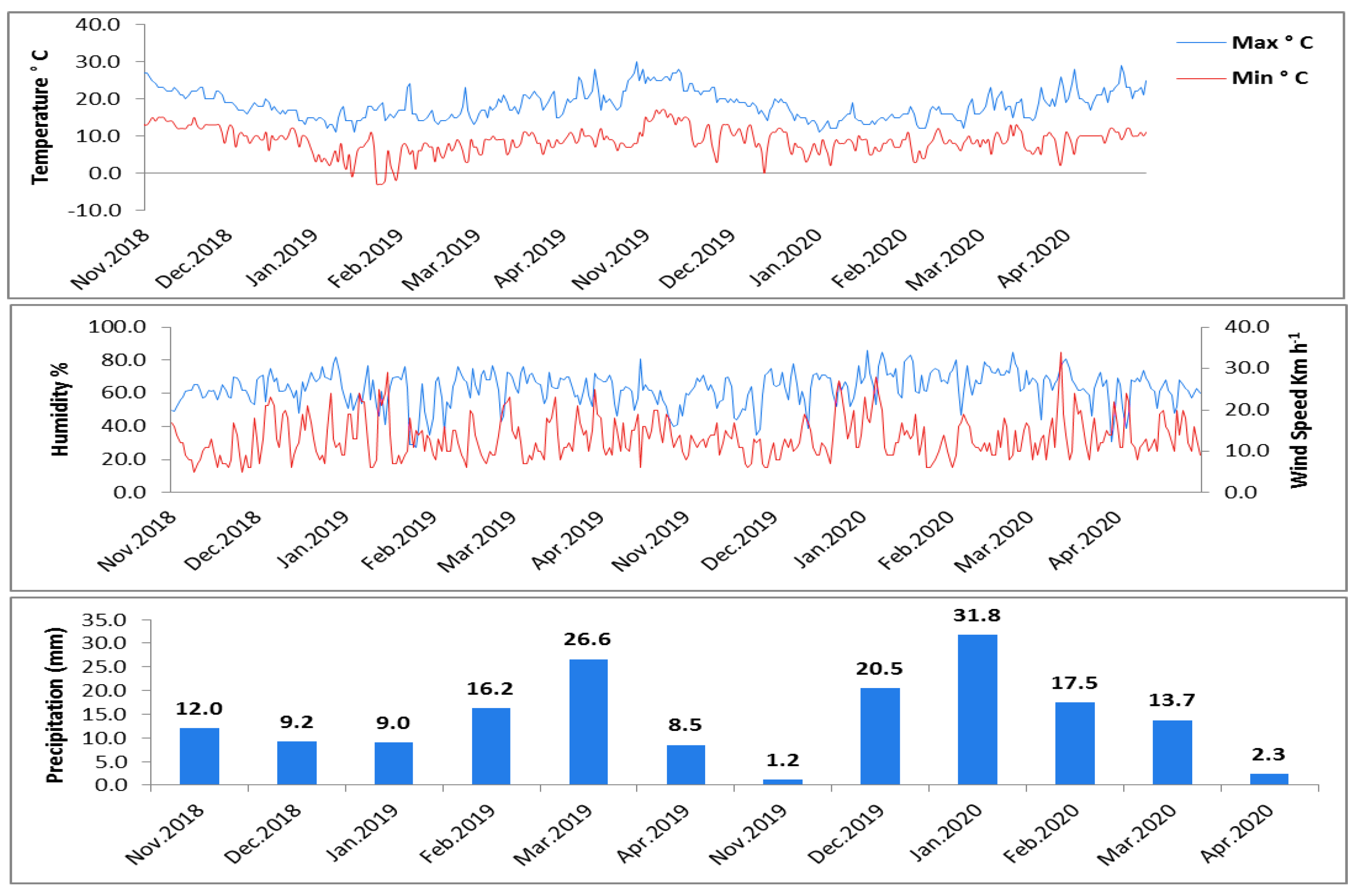
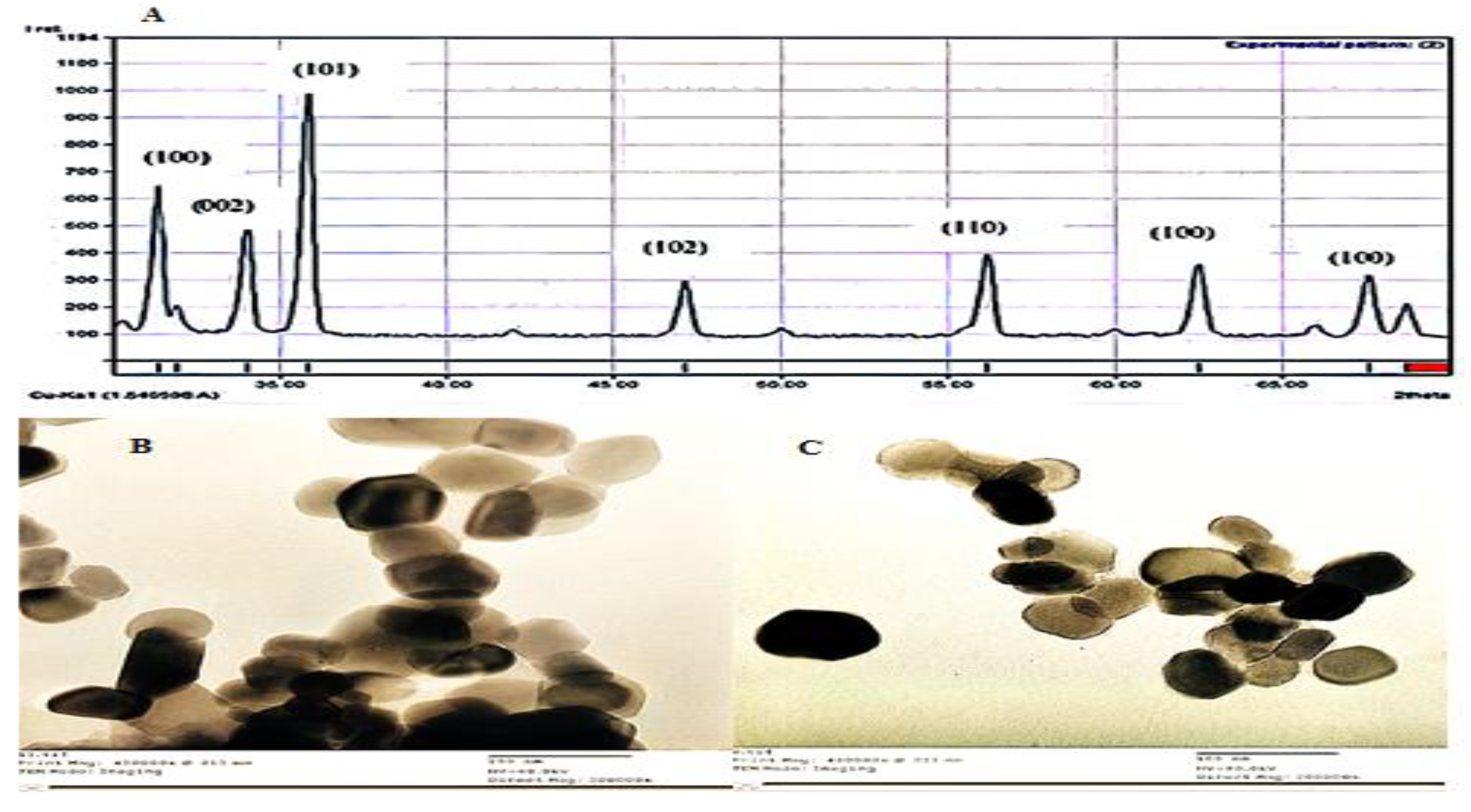
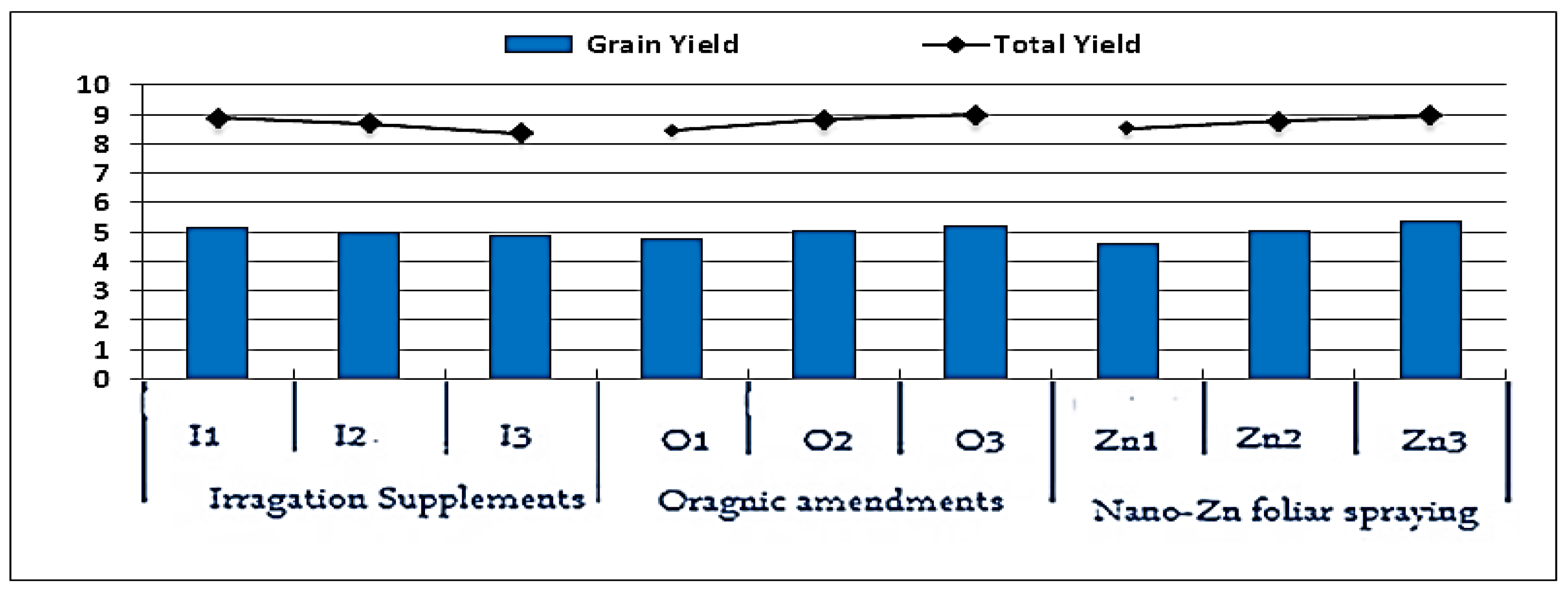
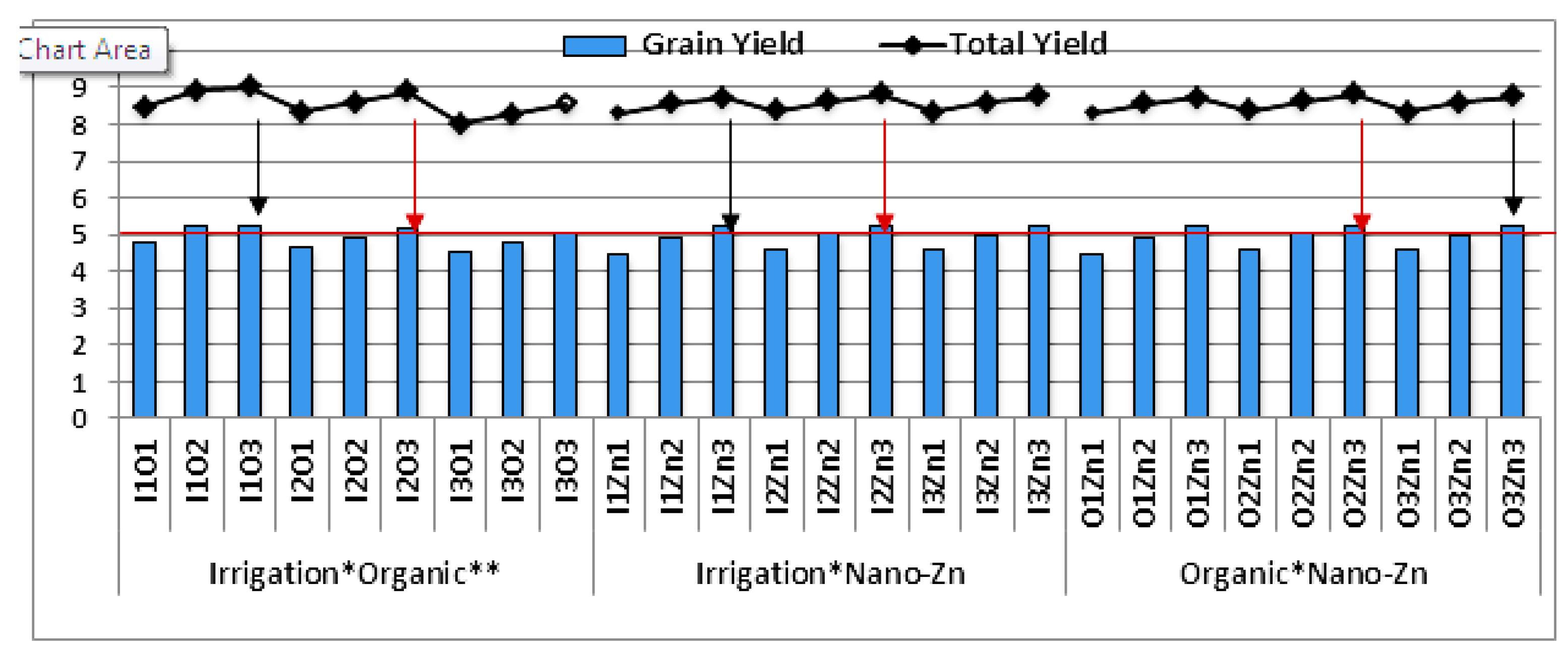
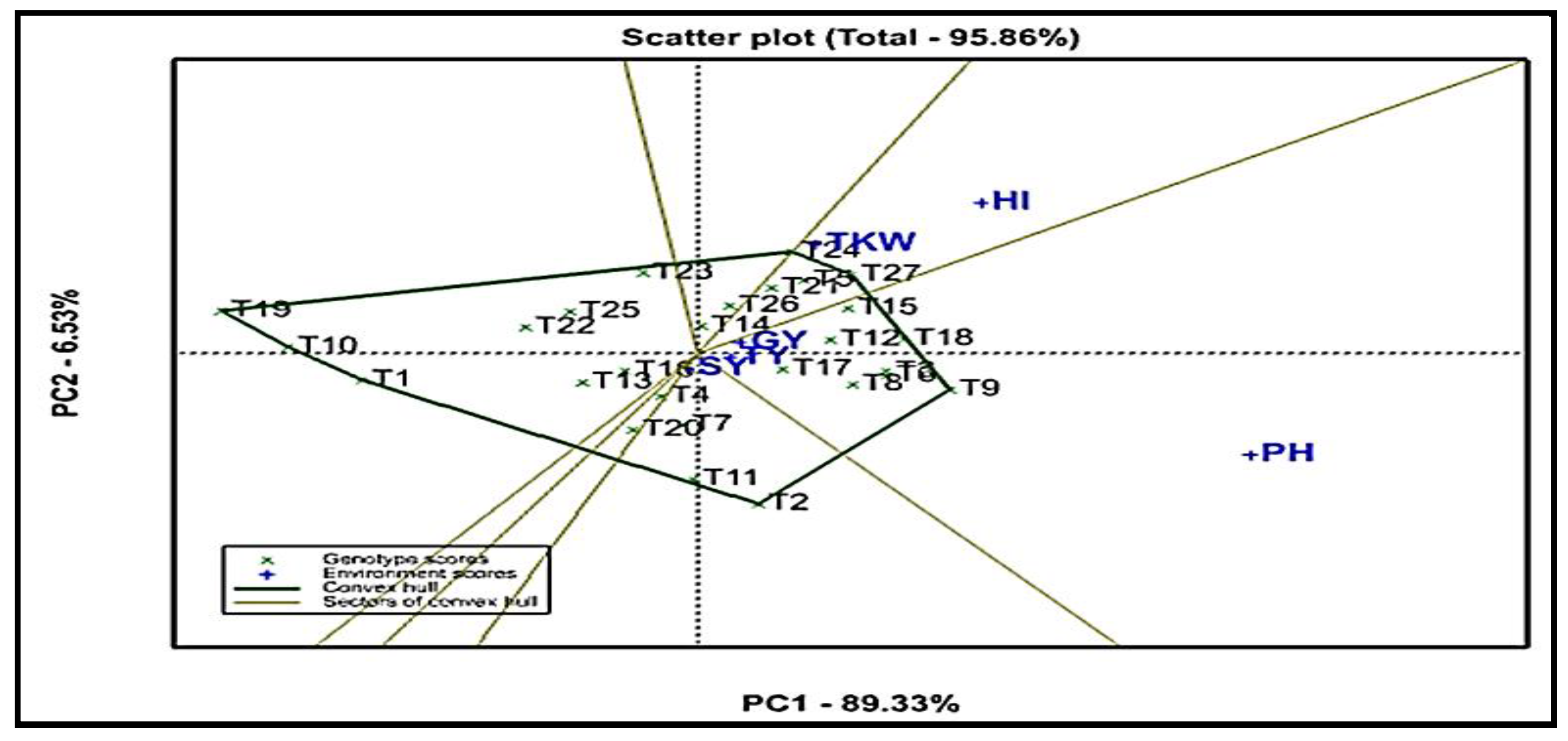

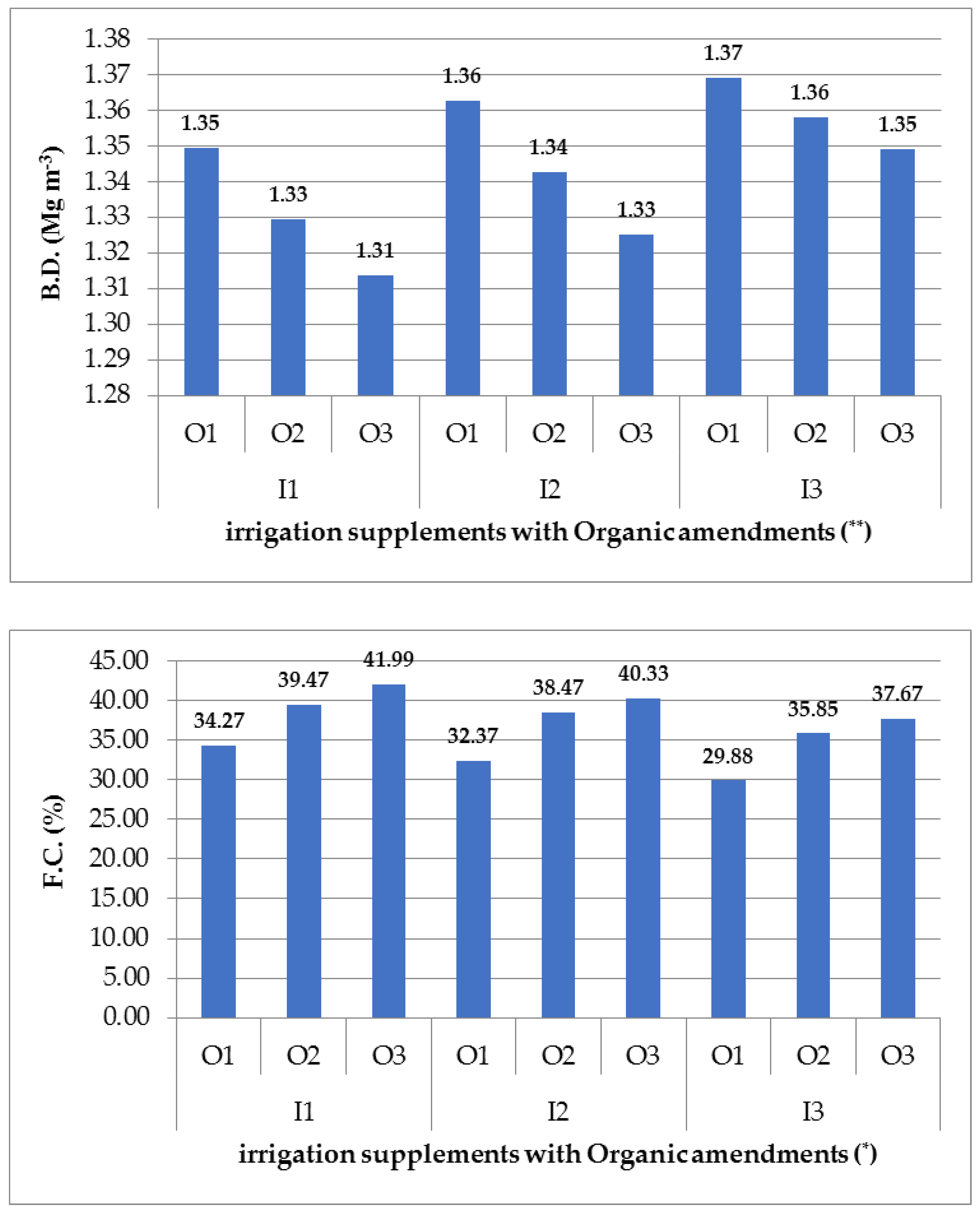
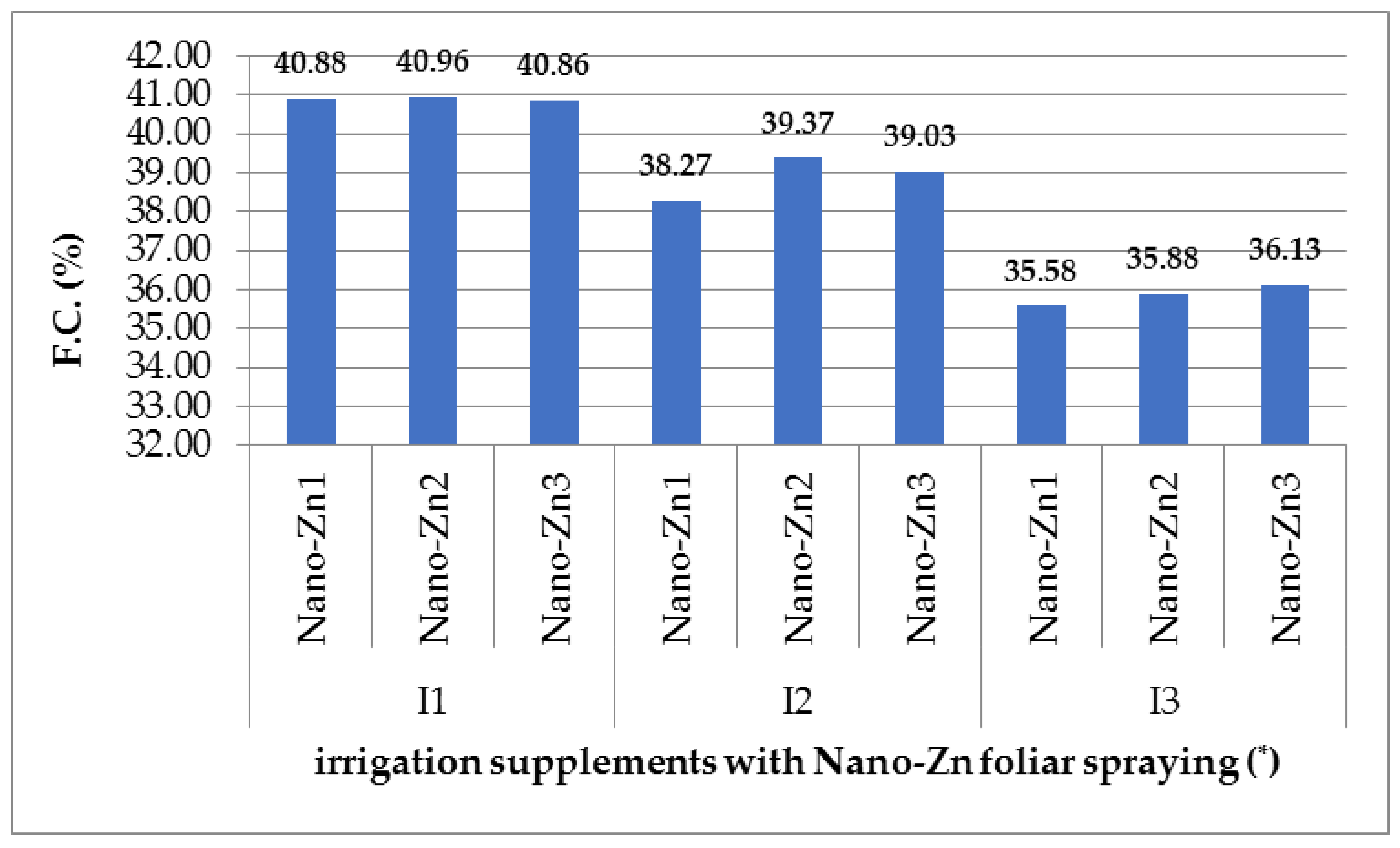

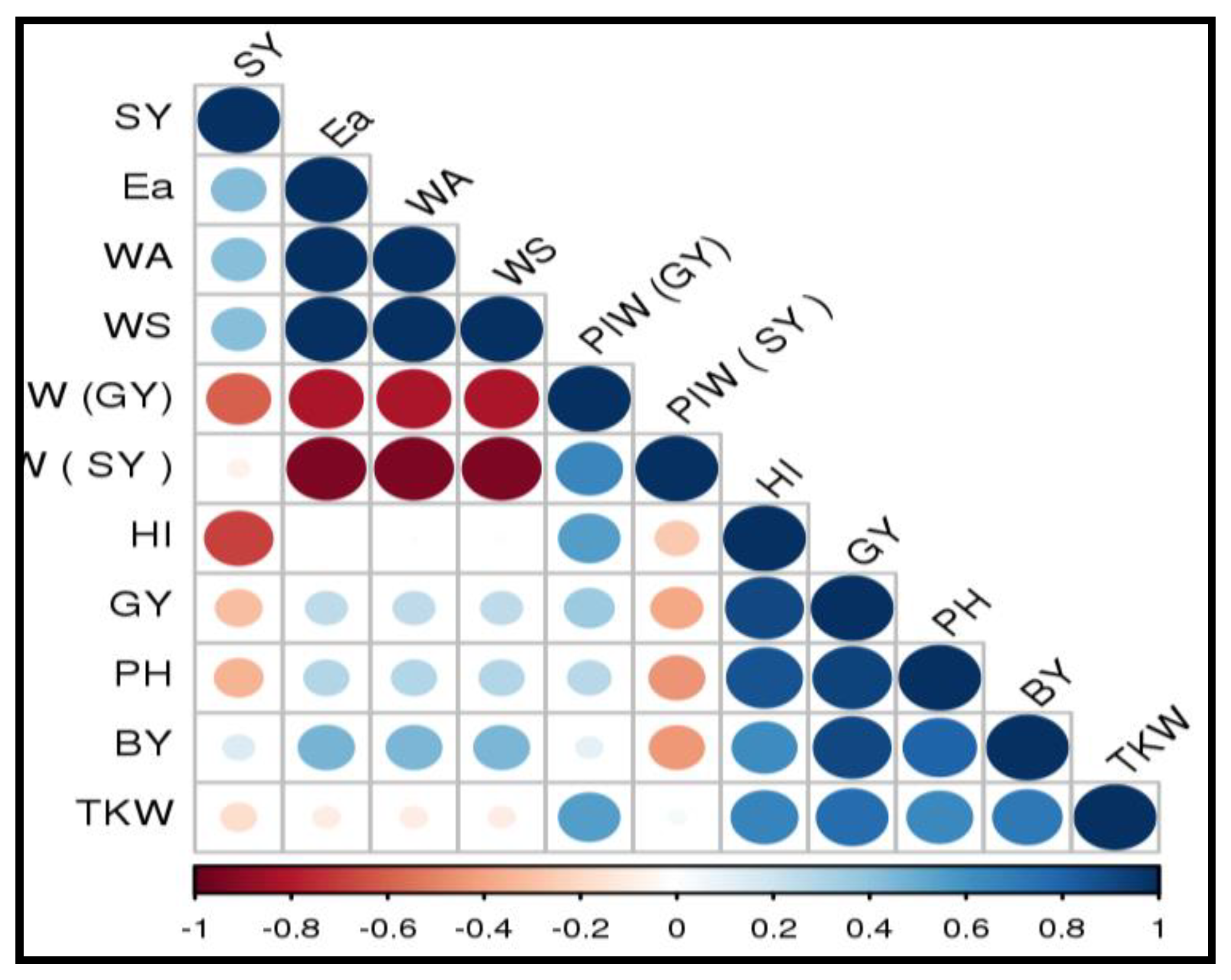
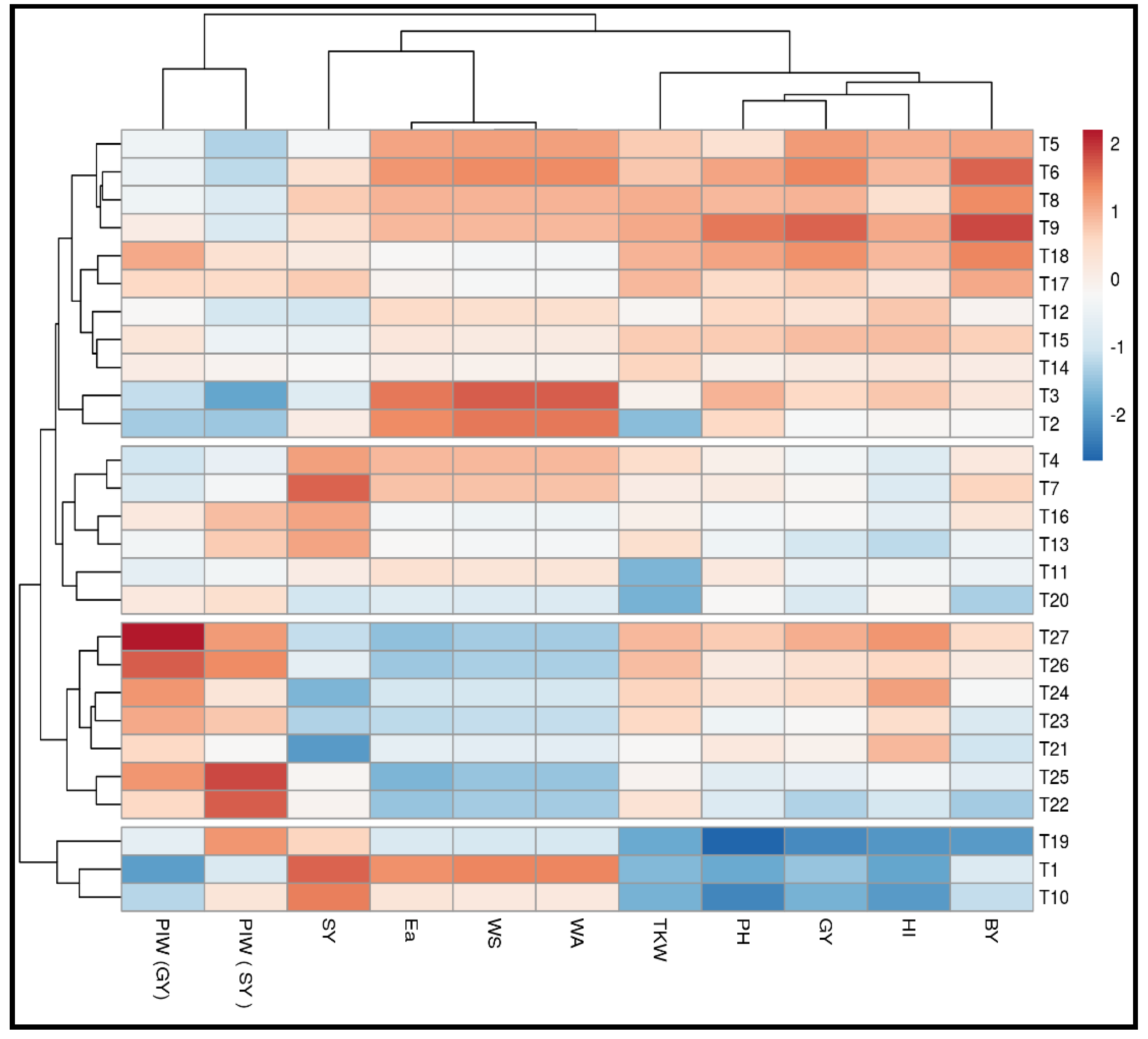
| Physical Soil Properties | ||||||||
|---|---|---|---|---|---|---|---|---|
| Soil Moisture Characteristics (%) | BD (Mg m−3) | T.P (%) | Particle Size Distribution (%) | |||||
| F.C. | W.P. | A.W. | Sand | Silt | Clay | Texture | ||
| 41.51 | 21.59 | 20.53 | 1.35 | 49.06 | 17.96 | 25.13 | 56.92 | Clayey |
| Chemical Soil Characteristics | ||||||||
| pH | ECe (dS m−1) | ESP (%) | CEC (cmol kg−1) | OM (%) | CaCO3 (g kg−1) | N | P | K |
| (mg kg−1) | ||||||||
| 8.38 | 4.81 | 10.15 | 37.93 | 0.86 | 2.61 | 30.89 | 8.13 | 255.13 |
| Raw Materials | pH * | ECe * (dS m−1) | O.M (%) | O.C (%) | C/N Ratio | Total Nutrients (%) | ||
|---|---|---|---|---|---|---|---|---|
| N | P | K | ||||||
| Compost | 7.71 | 4.09 | 26.89 | 15.60 | 18.00 | 1.75 | 0.92 | 1.25 |
| Vermicompost | 7.62 | 4.59 | 31.92 | 18.56 | 11.46 | 1.69 | 1.26 | 1.31 |
| No | Irrigation Supplements | Organic Amendments | Nano-Zinc Foliar Spraying | Symbol | Bi-Plot |
|---|---|---|---|---|---|
| 1 | 100% Full water requirement (I1) | Control (O1) | Without (Zn1) | I1O1ZN1 | T1 |
| 2 | 1 g/L (Zn2) | I1O1ZN2 | T2 | ||
| 3 | 2 g/L (Zn3) | I1O1ZN3 | T3 | ||
| 4 | Compost (O2) | Without (Zn1) | I1O2ZN1 | T4 | |
| 5 | 1 g/L (Zn2) | I1O2ZN2 | T5 | ||
| 6 | 2 g/L (Zn3) | I1O2ZN3 | T6 | ||
| 7 | Vermicompost (O3) | Without (Zn1) | I1O3ZN1 | T7 | |
| 8 | 1 g/L (Zn2) | I1O3ZN2 | T8 | ||
| 9 | 2 g/L (Zn3) | I1O3ZN3 | T9 | ||
| 10 | 85% of water requirement (I2) | Control (O1) | Without (Zn1) | I2O1ZN1 | T10 |
| 11 | 1 g/L (Zn2) | I2O1ZN2 | T11 | ||
| 12 | 2 g/L (Zn3) | I2O1ZN3 | T12 | ||
| 13 | Compost (O2) | Without (Zn1) | I2O2ZN1 | T13 | |
| 14 | 1 g/L (Zn2) | I2O2ZN2 | T14 | ||
| 15 | 2 g/L (Zn3) | I2O2ZN3 | T15 | ||
| 16 | Vermicompost (O3) | Without (Zn1) | I2O3ZN1 | T16 | |
| 17 | 1 g/L (Zn2) | I2O3ZN2 | T17 | ||
| 18 | 2 g/L (Zn3) | I2O3ZN3 | T18 | ||
| 19 | 65% of water requirement (I3) | Control (O1) | Without (Zn1) | I3O1ZN1 | T19 |
| 20 | 1 g/L (Zn2) | I3O1ZN2 | T20 | ||
| 21 | 2 g/L (Zn3) | I3O1ZN3 | T21 | ||
| 22 | Compost (O2) | Without (Zn1) | I3O2ZN1 | T22 | |
| 23 | 1 g/L (Zn2) | I3O2ZN2 | T23 | ||
| 24 | 2 g/L (Zn3) | I3O2ZN3 | T24 | ||
| 25 | Vermicompost (O3) | Without (Zn1) | I3O3ZN1 | T25 | |
| 26 | 1 g/L (Zn2) | I3O3ZN2 | T26 | ||
| 27 | 2 g/L (Zn3) | I3O3ZN3 | T27 |
| Season | 1st Season, 2018/2019 | 2nd Season 2019/2020 | ||||||||||
|---|---|---|---|---|---|---|---|---|---|---|---|---|
| Trait Treatment | BY1 | GY1 | SY1 | TKW 1 | PH1 | HI1 | BY2 | GY2 | SY2 | TKW 2 | PH2 | HI2 |
| Irrigation supplements (I) | ||||||||||||
| I1 | 8.80 | 5.04 | 3.76 | 58.07 | 93.85 | 57.25 | 8.94 | 5.23 | 3.71 | 59.54 | 96.22 | 58.48 |
| I2 | 8.61 | 4.89 | 3.72 | 57.93 | 91.81 | 56.76 | 8.74 | 5.10 | 3.64 | 59.38 | 94.22 | 58.31 |
| I3 | 8.28 | 4.75 | 3.53 | 57.78 | 89.81 | 57.31 | 8.42 | 4.95 | 3.47 | 59.25 | 91.89 | 58.72 |
| F-test | ** | * | NS | ** | ** | NS | ** | * | NS | ** | ** | NS |
| LSD | 0.091 | 0.189 | - | 0.029 | 1.275 | - | 0.101 | 0.142 | - | 0.017 | 1.023 | - |
| Organic amendments (O) | ||||||||||||
| O1 | 8.47 | 4.63 | 3.65 | 55.84 | 89.26 | 55.90 | 8.42 | 4.84 | 3.58 | 57.72 | 92.33 | 57.47 |
| O2 | 8.91 | 4.95 | 3.64 | 58.93 | 92.22 | 57.59 | 8.72 | 5.14 | 3.58 | 60.20 | 94.11 | 58.93 |
| O3 | 9.02 | 5.11 | 3.72 | 59.01 | 94.00 | 57.83 | 8.96 | 5.30 | 3.66 | 60.25 | 95.89 | 59.10 |
| F-test | ** | ** | NS | ** | ** | ** | ** | ** | NS | ** | ** | * |
| LSD | 0.026 | 0.099 | - | 1.262 | 1.666 | 1.153 | 0.026 | 0.097 | - | 1.277 | 1.896 | 1.101 |
| Nano-Zn foliar spraying (Zn) | ||||||||||||
| Zn1 | 8.56 | 4.52 | 3.82 | 57.14 | 86.81 | 54.14 | 8.48 | 4.69 | 3.79 | 58.80 | 89.22 | 55.33 |
| Zn2 | 8.83 | 4.96 | 3.63 | 57.84 | 92.89 | 57.69 | 8.73 | 5.09 | 3.64 | 59.32 | 95.33 | 58.27 |
| Zn3 | 9.01 | 5.21 | 3.55 | 58.80 | 95.78 | 59.49 | 8.90 | 5.51 | 3.39 | 60.05 | 97.78 | 61.91 |
| F-test | ** | ** | ** | ** | ** | ** | ** | ** | ** | ** | ** | ** |
| LSD | 0.036 | 0.094 | 0.12 | 0.521 | 0.871 | 1.25 | 0.041 | 0.102 | 0.117 | 0.592 | 1.216 | 1.237 |
| Seasons | 1st, 2018/2019 | 2nd, 2019/2020 | ||||||||
|---|---|---|---|---|---|---|---|---|---|---|
| Properties Treatment | WA | WS | Ea | PIW (Grain) | PIW (Straw) | WA | WS | Ea | PIW (Grain) | PIW (Straw) |
| Irrigation supplements (I) | ||||||||||
| I1 | 3835 | 2825 | 73.64 | 1.32 | 0.98 | 3722 | 2877 | 77.29 | 1.41 | 1.00 |
| I2 | 3335 | 2325 | 69.69 | 1.47 | 1.12 | 3077 | 2232 | 72.52 | 1.66 | 1.19 |
| I3 | 2899 | 1889 | 65.11 | 1.64 | 1.22 | 2776 | 1931 | 69.53 | 1.79 | 1.25 |
| Organic amendments (O) | ||||||||||
| O1 | 3491 | 2482 | 70.72 | 1.34 | 1.06 | 3326 | 2482 | 74.26 | 1.47 | 1.09 |
| O2 | 3280 | 2270 | 68.79 | 1.49 | 1.13 | 3089 | 2244 | 72.26 | 1.65 | 1.18 |
| O3 | 3238 | 2228 | 68.37 | 1.60 | 1.16 | 3100 | 2255 | 72.32 | 1.73 | 1.20 |
| Nano-Zn foliar spraying (Zn) | ||||||||||
| Zn1 | 3298 | 2289 | 68.94 | 1.39 | 1.17 | 3136 | 2292 | 72.63 | 1.52 | 1.22 |
| Zn2 | 3366 | 2356 | 69.59 | 1.49 | 1.09 | 3189 | 2344 | 73.10 | 1.62 | 1.16 |
| Zn3 | 3405 | 2395 | 69.92 | 1.55 | 1.06 | 3249 | 2405 | 73.62 | 1.72 | 1.06 |
| Properties Treatment | ECe dS m−1 | ESP | BD Mg m−3 | SOC % | A.N mg kg−1 | F.C. % |
|---|---|---|---|---|---|---|
| Irrigation supplements (I) | ||||||
| I1 | 3.41 | 9.19 | 1.33 | 0.65 | 38.58 | 44.5 |
| I2 | 3.87 | 10.43 | 1.34 | 0.61 | 37.06 | 43.34 |
| I3 | 4.12 | 11.11 | 1.36 | 0.54 | 34.47 | 40.51 |
| F-test | ** | ** | ** | ** | ** | ** |
| LSD | 0.09 | 0.23 | 0.003 | 0.006 | 0.21 | 0.42 |
| Organic amendments (O) | ||||||
| O1 | 3.88 | 10.48 | 1.36 | 0.48 | 32.18 | 38.55 |
| O2 | 3.86 | 10.34 | 1.34 | 0.64 | 37.93 | 44.06 |
| O3 | 3.66 | 9.91 | 1.33 | 0.69 | 40.00 | 45.74 |
| F-test | ** | ** | ** | ** | ** | ** |
| LSD | 0.06 | 0.14 | 0.002 | 0.005 | 0.21 | 0.42 |
| Nano-Zn foliar spraying (Zn) | ||||||
| Zn1 | 3.84 | 10.43 | 1.35 | 0.61 | 36.35 | 42.41 |
| Zn2 | 3.79 | 10.23 | 1.35 | 0.60 | 36.74 | 42.74 |
| Zn3 | 3.77 | 10.07 | 1.34 | 0.59 | 37.02 | 43.21 |
| F-test | NS | NS | * | ** | ** | ** |
| LSD | NS | NS | 0.007 | 0.003 | 0.19 | 0.24 |
| The interaction (F-test) | ||||||
| I*O | NS | NS | ** | NS | NS | * |
| I*Zn | NS | NS | NS | NS | NS | * |
| O*Zn | -NS | NS | NS | NS | NS | NS |
| I*O* Zn | NS | NS | NS | NS | NS | NS |
Publisher’s Note: MDPI stays neutral with regard to jurisdictional claims in published maps and institutional affiliations. |
© 2022 by the authors. Licensee MDPI, Basel, Switzerland. This article is an open access article distributed under the terms and conditions of the Creative Commons Attribution (CC BY) license (https://creativecommons.org/licenses/by/4.0/).
Share and Cite
Khalifa, T.H.; Mariey, S.A.; Ghareeb, Z.E.; Khatab, I.A.; Alyamani, A. Effect of Organic Amendments and Nano-Zinc Foliar Application on Alleviation of Water Stress in Some Soil Properties and Water Productivity of Barley Yield. Agronomy 2022, 12, 585. https://doi.org/10.3390/agronomy12030585
Khalifa TH, Mariey SA, Ghareeb ZE, Khatab IA, Alyamani A. Effect of Organic Amendments and Nano-Zinc Foliar Application on Alleviation of Water Stress in Some Soil Properties and Water Productivity of Barley Yield. Agronomy. 2022; 12(3):585. https://doi.org/10.3390/agronomy12030585
Chicago/Turabian StyleKhalifa, Tamer H., Samah A. Mariey, Zeinab E. Ghareeb, Ismael A. Khatab, and Amal Alyamani. 2022. "Effect of Organic Amendments and Nano-Zinc Foliar Application on Alleviation of Water Stress in Some Soil Properties and Water Productivity of Barley Yield" Agronomy 12, no. 3: 585. https://doi.org/10.3390/agronomy12030585
APA StyleKhalifa, T. H., Mariey, S. A., Ghareeb, Z. E., Khatab, I. A., & Alyamani, A. (2022). Effect of Organic Amendments and Nano-Zinc Foliar Application on Alleviation of Water Stress in Some Soil Properties and Water Productivity of Barley Yield. Agronomy, 12(3), 585. https://doi.org/10.3390/agronomy12030585






